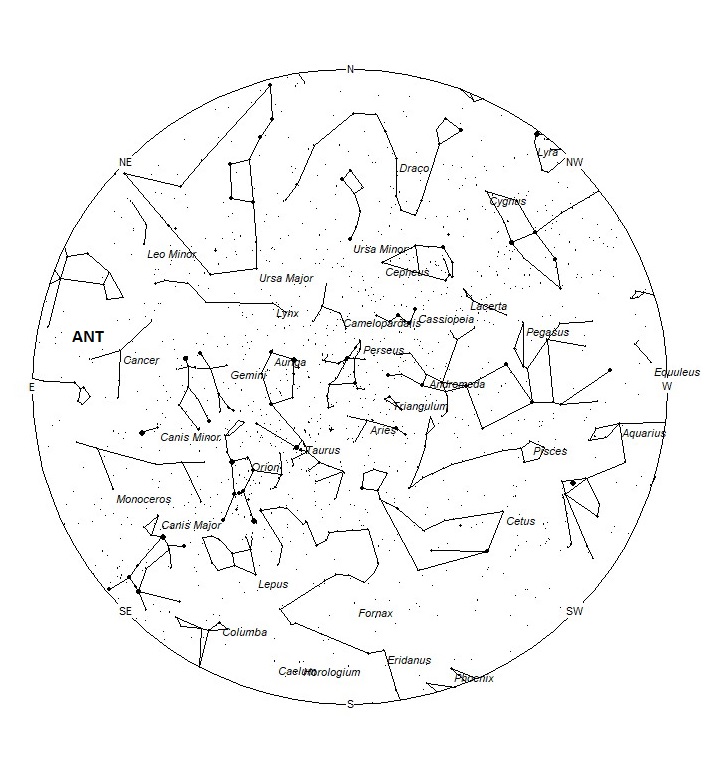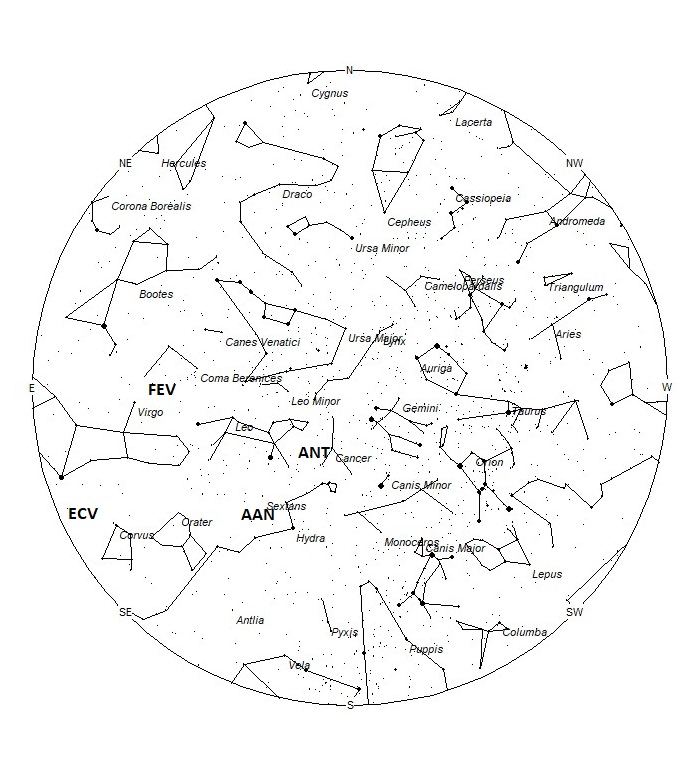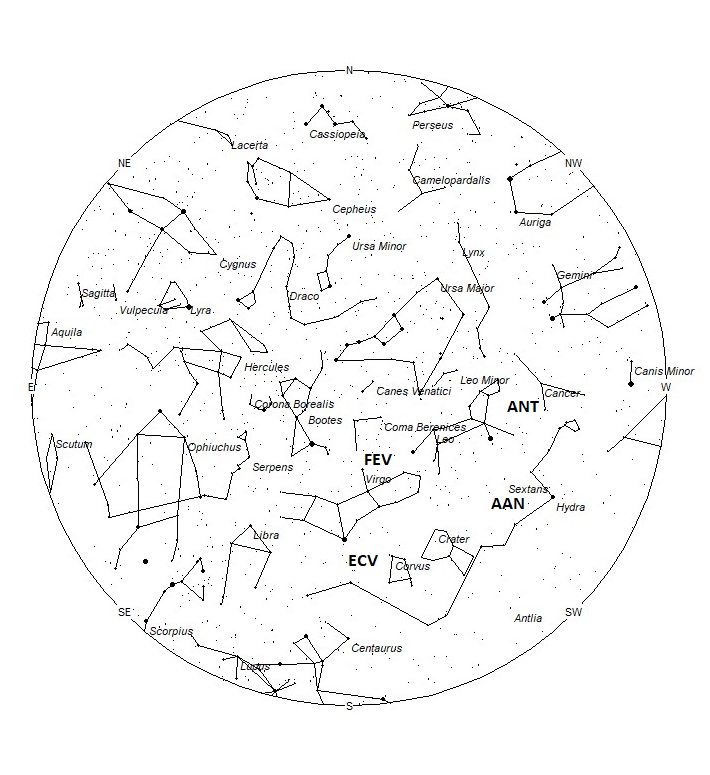
During this period the moon waxes from new to nearly half-illuminated. This weekend the moon will lie near the sun and will be invisible at night. As the week progresses the waxing crescent moon will enter the evening sky but set long before the more active morning hours arrive. The estimated total hourly meteor rates for evening observers this week is near 2 for those viewing from the northern hemisphere and 3 for those located south of the equator. For morning observers the estimated total hourly rates should be near 11 as seen from mid-northern latitudes (45N) and also 13 as seen from tropical southern locations (25S). The actual rates will also depend on factors such as personal light and motion perception, local weather conditions, alertness and experience in watching meteor activity. Note that the hourly rates listed below are estimates as viewed from dark sky sites away from urban light sources. Observers viewing from urban areas will see less activity as only the brighter meteors will be visible from such locations.
The radiant (the area of the sky where meteors appear to shoot from) positions and rates listed below are exact for Saturday night/Sunday morning January 25/26. These positions do not change greatly day to day so the listed coordinates may be used during this entire period. Most star atlases (available at science stores and planetariums) will provide maps with grid lines of the celestial coordinates so that you may find out exactly where these positions are located in the sky. A planisphere or computer planetarium program is also useful in showing the sky at any time of night on any date of the year. Activity from each radiant is best seen when it is positioned highest in the sky, either due north or south along the meridian, depending on your latitude. It must be remembered that meteor activity is rarely seen at the radiant position. Rather they shoot outwards from the radiant so it is best to center your field of view so that the radiant lies at the edge and not the center. Viewing there will allow you to easily trace the path of each meteor back to the radiant (if it is a shower member) or in another direction if it is a sporadic. Meteor activity is not seen from radiants that are located below the horizon. The positions below are listed in a west to east manner in order of right ascension (celestial longitude). The positions listed first are located further west therefore are accessible earlier in the night while those listed further down the list rise later in the night.
These sources of meteoric activity are expected to be active this week.
The large Anthelion (ANT) radiant is currently centered at 09:16 (139) +16. This position lies in eastern Cancer, 5 degrees northeast of the 4th magnitude star known as Acubens (alpha Cancri). Since the radiant is so large, Anthelion activity may also appear from western Leo and northwestern Hydra as well as Cancer. This radiant is best placed near 01:00 local standard time (LST) when it lies on the meridian and is highest in the sky. Rates at this time should be near 3 per hour as seen from the northern hemisphere and 2 per hour as seen from south of the equator. With an entry velocity of 30 km/sec., the average Anthelion meteor would be of slow velocity.
The alpha Antliids (AAN) should be active from a radiant located near 10:08 (152) -07. This position actually lies in southern Sextans, directly between the faint stars known as alpha Sextantis and lambda Hydrae. I’m not certain how this stream was named as it the radiant lies a good 20 degrees north of the Antlia border. Perhaps when activity was first noticed from this source the radiant was incorrectly determined? This radiant is best placed near 0200 LST, when it lies on the meridian and is located highest in the sky. Rates are expected to be less than 1 per hour no matter your location. With an entry velocity of 45 km/sec., the average meteor from this source would be of medium velocity.
The February Epsilon Virginids (FEV) were discovered by Kathryn Steakly & Dr. Peter Jenniskens using data from CAMS and SonotaCo. This shower is active from January 29-February 9, with maximum activity occurring on February 3rd. The radiant is currently located at 12:52 (193) +13, which places it on the border of Virgo and Coma Berenices, 3 degrees northwest of the 3rd magnitude star known as Vindemiatrix (Epsilon Virginis). These meteors would be best seen near 0500 LST when the radiant lies highest above the horizon. Current rates are expected to be less than 1 per hour no matter your location. These meteors are equally well seen from either hemisphere. These meteors encounter the atmosphere at 64 km/sec., which would produce mostly swift meteors.
The eta Corvids (ECV) were recently discovered by Sirko Molau and the IMO Video Meteor Network Team. This stream is active from January 16-29, with maximum activity occurring on the 22nd. The current position of the radiant is 13:04 (196) -19, which places the radiant in southern Virgo, 8 degrees southwest of the 1st magnitude star known as Spica (alpha Virginis). These meteors are best seen near 0400 LST when the radiant lies highest above the horizon. Current hourly rates would be less than 1 per hour as seen from the northern hemisphere and near 1 per hour as seen south of the equator. At 68 km/sec. these meteors would be swift.
As seen from the mid-northern hemisphere (45N) one would expect to see approximately 8 sporadic meteors per hour during the last hour before dawn as seen from rural observing sites. Evening rates would be near 2 per hour. As seen from the tropical southern latitudes (25S), morning rates would be near 10 per hour as seen from rural observing sites and 3 per hour during the evening hours. Locations between these two extremes would see activity between the listed figures.
The list below offers the information from above in tabular form. Rates and positions are exact for Saturday night/Sunday morning except where noted in the shower descriptions.
| SHOWER | DATE OF MAXIMUM ACTIVITY | CELESTIAL POSITION | ENTRY VELOCITY | CULMINATION | HOURLY RATE | CLASS |
| RA (RA in Deg.) DEC | Km/Sec | Local Standard Time | North-South | |||
| Anthelion (ANT) | – | 09:16 (139) +16 | 30 | 01:00 | 3 – 2 | II |
| alpha Antliids (AAN) | Feb 01 | 10:08 (152) -07 | 45 | 02:00 | <1 – <1 | IV |
| February Epsilon Virginids (FEV) | Feb 03 | 12:52 (193) +13 | 64 | 05:00 | <1 – <1 | IV |
| eta Corvids (ECV) | Jan 22 | 13:04 (196) -19 | 68 | 04:00 | <1 – 1 | IV |
 American Meteor Society
American Meteor Society



I’ve seen one few minutes ago….! It’s beautiful….!
I live in San Antonio Tx. I saw a blue meteor traveling north to south taking 4-5 seconds streaking through the sky very slow while breaking halve way through the sky into two.
I saw one last night, it was bright white and i watched as it fell apart.
It was my first time seeing one!!! 😀
I, literally just watched one go right over Laguna Woods ca…. It was amazing. I’ve never seen anything like that before in my life. It was so close, you felt like you reach out and touch it.
I saw one today Jan 29th at around 10:20pm! It was all fire, and it looks very low! Beautiful!